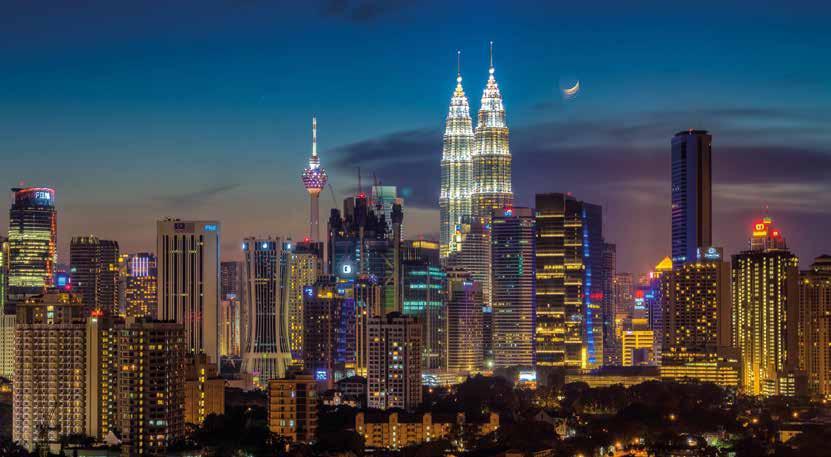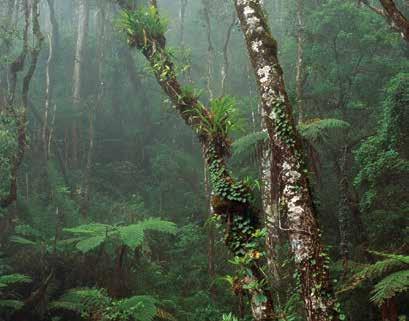
5 minute read
Special Malaysia
PIONEER IN CERTIFIED WOOD IN SOUTH-EAST ASIA
EXPORT OF SUSTAINABLY PRODUCED WOOD CONTINUES TO GROW
Advertisement
If we talk about hardwood in Asia, you probably think spontaneously of Malaysia. Malaysia, which is mainly an Islamic country and borders on Brunei, Indonesia, Singapore, and Thailand, has a surface area of 330,3434km² and is thereby about eleven times bigger than Belgium. In South-East Asia the country is by far the leading producer of scores of wood sorts, many of which are destined for export.
Before we consider what this country and its tropical climate (temperatures here are always between 27 and 34°C and the climate is humid) mean for the wood and parquet industry in our part of the world, we need to have a brief look at the country itself. The first thing which stands out is how this nation actually comprises two parts, which are separated by the South China Sea. On the one side you have Malacca (or West Malaysia), which abuts Thailand in the north and envelops Singapore in the south. There is also East Malaysia, which comprises Sabah, Sarawak, Labuan, and the northern part of Borneo, which borders on Indonesia in the south and surrounds Brunei in the north. As regards surface area, you notice that Malacca covers about 40% of the country’s surface area; this is precisely where most of the estimated 32.7 million people live. Over 85% of the population lives in Malacca. Moreover, it is also noticeable that over 70% live in towns and cities, as the population exploded after 1950. By comparison, in 1950, the country had barely six million inhabitants. That population explosion has been slowing down for some time, mainly due to a falling birth rate.
Malays, Chinese, and Tamils
The population itself is reasonably diverse. By far the biggest ethnic group is that of the Malays, who comprise about 60% of the population. Then you have the Chinese (24%), a major second ethnic group.
The latter are much fewer in number, but they do have considerable impact. Indeed, these Chinese occupy a dominant position in trade and industry and, together with the Indians, the biggest part of the non-farming working population. This leads us to the third group, the Indians, who comprise mainly Tamils and make up 8% of the population.
To complete the picture in full, the Federation of Malaysia is a constitutional monarchy. The leader (or Yang di-Pertuan Agong) is the head of state. Actually, you can also call this head of state a king, except for the fact that the Kings of Malaysia are chosen for terms of five years from the nine sultans of the states of the peninsula of Malacca. The present king is Sultan Abdullah of Pahang.
Economy: mining, oil, and, yes, wood
Obviously, what we are mainly interested in is the economy. It is noticeable that the major branches of industry are mining and trade in petroleum (and natural gas), and not forestry. The major mining products are bauxite, gold, iron, and manganese. Oil is produced on Sarawak and off-shore at Sabah, but large stocks of petroleum and natural gas have also been found near Kuantan (West Malaysia). If we look specifically at the wood sector, the main observation is that Malaysia is one of the world’s biggest tropical suppliers of sawn hardwood, triplex, and other sheet materials, terrace boards, floorboards, furniture, panels, finger joint and/or laminated products, doors, and planed wood (skirting boards and profiles). The wood sector share in the economy is fairly large, as illustrated by the somewhat more than 3,500 wood businesses. The most recent figures are not yet available, but the fact that the total turnover of those companies in 2017 amounted to over 10 billion euros give you some idea. Moreover, half of that 10 billion was earned from exports. There is a particularly wide range of wood sorts since the country numbers over 2,600 types of trees. They include well known names such as dark red meranti, bintangor, gerutu, jelutong, keruing, sepetir, merbau, nyatoh, (red) balau, kembang semangkok, kempas, and rubber wood. It is worth noting here that Malaysia itself has started to import wood from other countries all over the world, mainly because of its own decreasing stocks. That wood is processed and re-exported all over the world. The rest of the world in this case means primarily Japan, the USA, the European Union, India, South Korea, Australia, China, Singapore, Thailand, and the Philippines.
Certification getting more and more important
Deforestation, illegal cutting, and the climate are real issues. When it comes to forests, you invariably think of the Amazon region. Nevertheless, South-East Asia, and certainly Malaysia, have problems of their own in this respect. Environmental issues haven’t fallen on deaf ears in Malaysia and they’ve been working for several years to offer more and more certified wood, with the Malaysian Timber Industry Board being one of the driving forces. Moreover, that same MTIB has proposed that in the near future the country should aim for a division of 40% sawn wood for the export volume. The portion of wood to be processed further would therefore come out at 60%. They are responding here to forecasts, which suggest that the demand for sustainable certified wood and semi-finished products will continue to rise.
As we’ve mentioned above, Malaysia is committing itself increasingly to certification. For a long time, the country had a reputation for an attitude of ‘anything goes’, but they have obviously made serious attempts to bring about change here.
In their own Asiatic region, the wood producing countries have started to take serious import and export measures in recent years in relation to illegally cut wood. Malaysia is most certainly one of the pioneers within this group because the country has been working for much longer to combat illegal wood cutting and is striving for responsible forestry and certification. For instance, in 2001, the country introduced the Malaysian Timber Certification Scheme, the first certification system for tropical wood in Asia. This is based on the ITTO standards, certifies the forest management and the Chain of Custody, and was approved in 2009 by PEFC International.
Certificates for 22 sorts of wood products
The certificates cover 22 sorts of wood products and thereby the country trades globally in sustainably cultivated wood products, including with Belgium and, obviously, the Netherlands. We close with an interesting fact. At the start of this year, Malaysia was striving to reach 375,000 hectares of plantations. To achieve that, the country would need to plant 25,000 hectares of tree sorts each year to yield high quality wood over a period of about 15 years. The idea is that makers of floors, planed products, veneer, and furniture can start to benefit from this from 2021 onwards.
Major sources of information: Malaysian Timber Council, www.maleisie.be and the trade journal ‘Houtwereld’.












